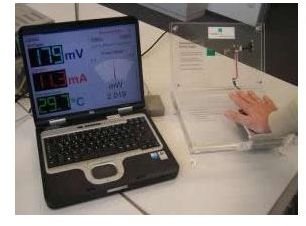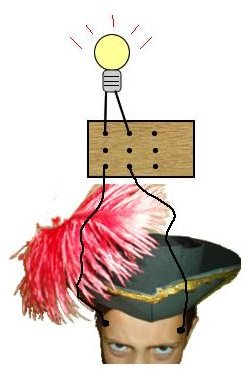What is Human Energy Harvesting & How is it Done?
The human body is a natural energy generator. From chemical and thermal processes produced from our eating, kinetic energy
produced from our movements, electrical activity produced from our brain, biomass waste produced from our bodies, and fluid flow engendered by our respiration, we are prolific energy producing factories.
Energy harvesting uses natural processes such as wind and tidal waves to capture and store energy. This energy is transformed into a different form, such as electricity, to power devices. The goal of human energy harvesting is the same. Human beings store energy in various ways, and one of them is in the fat you produce when you nosh on your favorite cookies, for example.

The idea of using human motion to produce electricity is not new. Hand-cranks power radios, blenders, ipods, and many other electrical devices. In the search for “clean” sources of energy, scientists and engineers are now studying ways to make the process more ubiquitous and efficient. The stakes are huge, with projections in the range of billions of dollars.
Also, humans make good power sources. The energy would be basically always available, has a small thermal footprint, and does not require any special fuel. Using human energy that would normally go to waste would be an ultimate achievement in recycling.
How Noshing Helps The Cause
The average human who has 15% body fat can produce 11 kilowatt hours of energy. The average human also eats about 3.3 kilowatt

hours per day. The first law of thermodynamics prevents total energy capture, but you are of interest for harvesting because you have available approximately 128 watts when you stand, 163 watts when you walk normally, and 407 watts when you walk quickly. If you are a sprinter, over 1.6 kilowatts is available, and if you are a long distance runner, you have about 1 kilowatt available. Being asleep you are still useful; then you contribute 81 watts of power.
Of course the available energy production varies according to age, weight, metabolism, gender, and health.
Walking, Running, Sitting
One technology is

done with the use of piezoelectric devices, which produce voltages upon the application of a mechanical strain. A heel strike using this can produce 1 to 2 watts per shoe. Other technologies try to harness the motion of your body, which produces oscillations. The movement of your body also makes your clothes move, and some researchers are studying this as a way of generating electricity. You’ve already seen sneakers with LEDs in them that light up as you walk, courtesy of LA Gear and Fayva.
Waste
Urine is of interest because it can be used to make fuel cells. It can be hydrolized to make carbon dioxide and ammonia, and then the ammonia can be oxidized to produce nitrogen and water. This technology still has difficulties, because sodium hydroxide is required to make it, and this is a hazardous substance to transport. Also, a technique such as reverse osmosis is required to produce a yield of 0.5 to 1 watt of power.
Inertia
SEIKO Watch Corporation uses inertia and nanontechnology to create self-winding wristwatches that generate electrical power by using a weight that swings when you move. They are reliable and accurate. For more information, you can read about their Kinetic Brand on their website, and IEEE Spectrum has a good article on inventor Kunio Koike.
Thermoelectricity

These devices function with the use of your body heat. They use metals, semiconductors, and ceramics to create devices that exploit a heat differential. Some of them use the Seebeck effect to generate electricity. In addition to educational institutions and companies, NASA is pushing ahead with efforts to make this technology work, despite concerns that the human body cannot produce enough of a temperature differential between itself and other objects on Earth.
Read more on page two…
Inside The Body
Natural motion inside of the body is also being studied by researchers for possible energy exploitation. The heart is of course a no-brainer; studies are being conducted to use its natural motion to generate electricity that can be used to operate pacemakers. The flow of blood, especially inside the brain, is also of interest.
Clothes and Gadgets
An electromagnetic knee braces that uses a computer to help control excess motion was developed at Professor Max Donelan’s Locomotion Lab at Simon Fraser University. The generator fires up when you are on the swinging phase of your walking motion. Walking one minute is enough to charge a cell phone for half an hour. The military is interested in this research because soldiers may carry up to 30 pounds of batteries for their equipment, and this device is only 3 lbs, though a 1 lb weight is now being developed.
A similar principle was used to develop a backpack, which is also of extreme interest to the military.

The movement of the wearer generates oscillations that are converted into electricity. This is done by the walker causing the bag to bounce on a spring that uses gears to connect to an electrical generator. The motion produces 20 watts, enough to power most portable devices, but it is heavy at 80 pounds. The inventor is Professor Larry Rome of the University of Pennsylvania.
At Professor Zhong Lin Wang’s Lab at the Georgia Institute of Technology, researchers have used nanotechnology to create clothes that are responsive to human movements. Specially made crystals are interwoven into fibers, and when these crystals are forced to bend by rubbing into each other, electricity is generated.
The Brain
Body heat and sunlight is used to power batteryless brainwave reading headphones. Hitachi is developing a device that turns the motion of blood in the brain into electricity to switch channels.
A Crowd Farm

The brainchild of two MIT grad students, the idea here is to use the kinetic energy of humans in crowded urban settings, such as from that of trains or concerts. The energy from people sitting, walking, or jumping would be transformed into electricity that could be used to power signs and other devices. As a test case that was performed at an Italian train site, the students did a demo where the weight of person sitting on a stool caused a flywheel to spin, thus powering a dynamo that in turn powered four LEDs.
One idea is that walking would depress a sub-flooring system comprised of blocks that would move in response. The slippage of the blocks against each other would be converted into electricity via the same process as that of a dynamo. Because a human step can only power two 60 watt lightbulbs for a second, this concept is best applied to a crowd, where over 28,527 steps can produce enough power for a moving train for one second. With enough steps, say 84,152,203, one can power the launch of a space shuttle.
For more on the progam, including pictures, visit MIT’s School of Architecture and Planning website.
Make your Own Project
Interested in making your own projects?

If you wish to start with shoes, you can modify a pair of your own using stepper motors and a circuit as done by these intrepid folks. They include pictures, videos, and instructions.
References
A Humorous Video Take On The Necessity Of Human Energy Harvesting
Space.com on Human Energy Harvesting
Popular Science’s Harvesting Energy From Humans
MIT’s Crowd Farm Project
TechOnline India’s Energy Harvesting Article (Includes Charts and Circuits For Your Inner Nerd)
Human Battery Science Fair Project
Image Credits
Crowd Farm Stool courtesy of MIT’s School of Architecture and Planning Website
Clothes by Jade
Tokyo Train Station by Andy Weisner
Human Battery By Gizmag
Energy Harvesting Shoes by Christian Croft and Kate Hartman
Pirate by Oakland
Hand-cranked phone charger by Virgin Media
Eating by Singhajaykr25
This post is part of the series: Energy Harvesting
Energy harvesting can be extremely beneficial to mankind. Find out what it’s all about!
